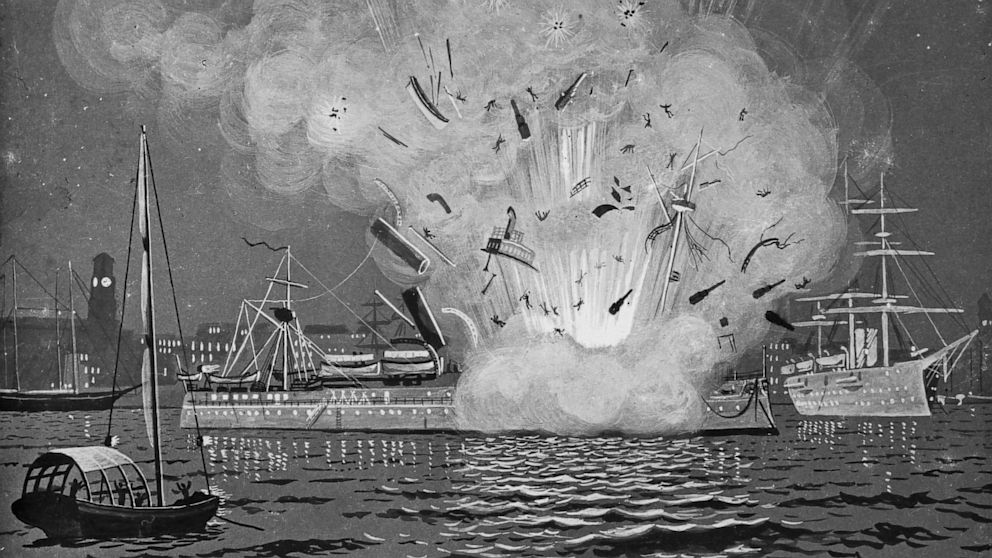This Week in History
From burning a president to dividing Berlin, here's this week in history.

Aug. 12, 2013 -- intro: Barriers dominate this week in history. Fifty-two years ago Tuesday, Berliners awoke to a city divided by a wall. Over a century before that, though, the barrier between the White House and the nation it serves might have been too thin for President Taylor, as he watched himself be burned in effigy by protesters. Here's what happened this week in history:
quicklist:1title:August 12text:1898: Spanish-American War Ends
On August 12, 1898, the five-month-long Spanish-American War came to a close. The peace agreement favored the militarily stronger U.S., which gained control of Cuba, Puerto Rico, and Manila in the Philippines from Spain.
The stage for the war set three years earlier, when Cuban forces rebelled against Spanish rule in 1895. After quelling the rebellion, the Spanish decided to enforce harsher conditions over the Cubans, who were then shuffled into guarded towns that were often plagued by disease.
In February 1898, a U.S. battleship sent to Havana to protect American citizens exploded—killing 260 crewmembers and enraging the public, who were convinced the Spanish were to blame.
This prompted President William McKinley to call for a force of 125,000 soldiers to fight the Spanish on April 23. In response, the Spanish declared war on America the following day, and the U.S. followed suit the day after that.
It took less than five months for the superior military strength of the U.S. (which included soldier and future president Teddy Roosevelt) to defeat the once-powerful Spain. The Treaty of Paris officially ended the short war on Dec. 10, 1898.
media:19938634
quicklist:2title:August 13text:1961: Berliners Awake to a Divided City
In the early morning hours of August 13, 1961, Soviet soldiers began laying the 100 miles of barbed wire that would separate East Berlin from West Berlin for 28 years.
The Communist leader of East Germany, Walter Ulbricht, had received Nikita Khrushchev's approval earlier that month for the construction of a wall that would separate the Communist-controlled East Berlin from the democratic West Berlin.
Between 1948 (when the Soviets began more strictly enforcing the city's division) and 1961, between 2.5 and 3 million citizens left East Germany for West Germany. In 1961, the daily defection rate to West Germany was approximately 1,000 people—most of them highly skilled laborers or intellectuals.
Berliners woke the morning of August 13 to find themselves cut off from half of their city. The Soviets soon replaced the barbed wire with six-foot high concrete wall that stretched nearly a hundred miles, with armed guards watching for escape attempts around the clock.
More than 28 years later, on November 9, 1989, East and West Berliners gathered at the wall to climb over it and dismantle it. The two halves of the city were officially reunited less than a year later, on October 3, 1990.
media:19938425
quicklist:3title:August 14text:1935: FDR Signs Social Security Act
In the midst of the Great Depression, President Franklin Delano Roosevelt signed the historic Social Security Act into law on Aug. 15, 1935. As part of Roosevelt's "New Deal" programs, the Social Security Act attempted to get America out of the Depression and alleviate widespread financial struggles.
Roosevelt especially felt concerned about the nation's young people and retirees, and stated that he didn't want them to "wonder what would be their lot when they came to old age."
Given the time period of its introduction, the act originally intended to combat unemployment, however, it currently functions as a safety net for retirees and the disabled, while also providing death benefits to dependents.
The act has remained largely unchanged since its introduction.
media:19938511
quicklist:4title:August 15text:1914: Panama Canal Opens to Traffic
The opening of the Panama Canal on Aug. 15, 1914 was inaugurated U.S. vessel, Ancon, became the first ship to cross.
Although the construction rights of the water passage were originally awarded by Colombia to French entrepreneur, Ferdinand de Lesseps, the outcome of the Spanish-American War and the independence of Panama allowed the U.S. to gain possession of the Panama Canal zone.
In exchange, Panama received $10 million and an annuity payment of $250,000 nine years later.
media:19938806
quicklist:5title:August 16text:1841: Protesters Burn President Tyler in Effigy
On Aug. 16, 1841, protesters burned an effigy of President John Tyler outside the White House to oppose the president's veto on re-establishing the Bank of the United States.
This was Tyler's second veto on re-establishing the Bank, which was first established in 1791 by Secretary of the Treasury Alexander Hamilton. In response, a riot that was dominated by Whigs (Tyler's own party) gathered outside the president's home.
They threw rocks at the windows, fired gunshots into the air, and hung a likeness of Tyler which was then lit on fire.
Tyler had supported the idea of a national bank as a senator—consistent with the Whig party—but, as president, he decided that it would be a violation of states' rights. This change of opinion enraged the Whig members of Congress, who marched from the Capitol to the White House upon hearing of the veto.
The riot was one of the most violent demonstrations that has ever taken place outside the White House and shortly led to the creation of Washington's own police force.
media:19938721




